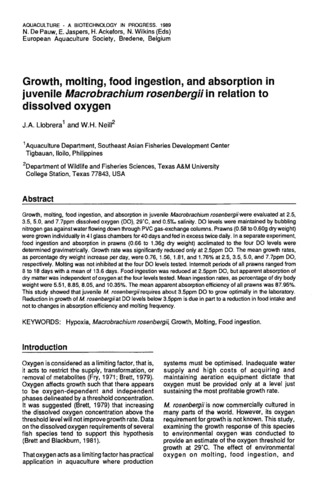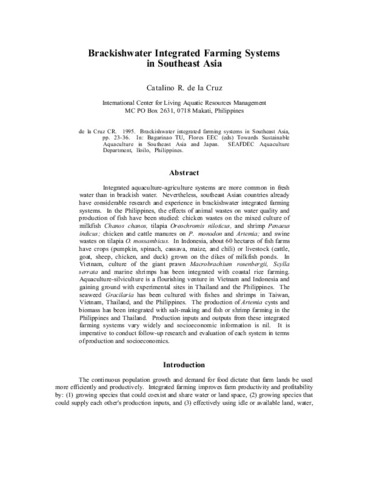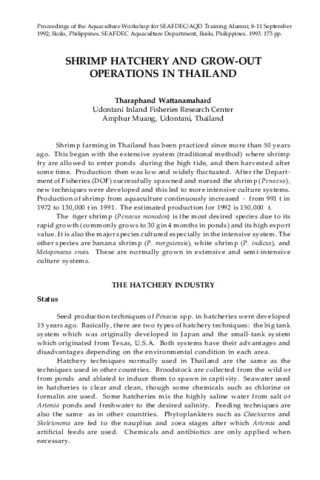Growth, molting, food ingestion, and absorption in juvenile Macrobrachium rosebergii in relation to dissolved oxygen
- Global styles
- MLA
- Vancouver
- Elsevier - Harvard
- APA
- Help
Share
Abstract
Growth, molting, food ingestion, and absorption in juvenile Macrobrachium rosenbergii were evaluated at 2.5, 3.5, 5.0, and 7.7ppm dissolved oxygen (DO), 29°C, and 0.5°/oo salinity. DO levels were maintained by bubbling nitrogen gas against water flowing down through PVC gas-exchange columns. Prawns (0.58 to 0.60g dry weight) were grown individually in 4 l glass chambers for 40 days and fed in excess twice daily. In a separate experiment, food ingestion and absorption in prawns (0.66 to 1.36g dry weight acclimated to the tour DO levels were determined gravimetrically. Growth rate was significantly reduced only at 2.5ppm DO. The mean growth rates, as percentage dry weight increase per day, were 0.76, 1.56, 1.81, and 1.76% at 2.5, 3.5, 5.0, and 7.7ppm DO, respectively. Molting was not inhibited at the tour DO levels tested. Intermolt periods of all prawns ranged trom 8 to 18 days with a mean of 13.6 days. Food ingestion was reduced at 2.5ppm DO, but apparent absorption of dry matter was independent of oxygen at the tour levels tested. Mean ingestion rates, as percentage of dry body weight were 5.51, 8.85, 8.05, and 10.35%. The mean apparent absorption efficiency of all prawns was 87.95%. This study showed that juvenile M. rosenbergii requires about 3.5ppm DO to grow optimally in the laboratory. Reduction in growth of M. rosenbergii at DO levels below 3.5ppm is due in part to a reduction in food intake and not to changes in absorption efficiency and molting frequency.
Suggested Citation
Llobrera, J. A., & Neill, W. H. (1989). Growth, molting, food ingestion, and absorption in juvenile Macrobrachium rosebergii in relation to dissolved oxygen. In N. De Pauw, E. Jaspers, H. Ackefors, & N. Wilkins (Eds.), Aquaculture—A Biotechnology in Progress. Proceedings of the International Conference Aquaculture Europe ’87, 2-5 June 1987, Amsterdam, The Netherlands (Vol. 1, pp. 395–400). Bredene, Belgium: European Aquaculture Society.
Type
Conference paperISBN
9071625036Collections
- Conference Proceedings [298]
Related items
Showing items related by title, author, creator and subject.
-
Shrimp grow-out culture techniques in the Philippines
Gicos, Apolinario (Aquaculture Department, Southeast Asian Fisheries Development Center, 1993)The major commercial shrimp species in the Philippines belong to the genus Penaeus and Metapenaeus. The important penaeid shrimps are: P. monodon (giant tiger shrimp or sugpo); P. japonicus and P. semisulcatus (tiger shrimp ... -
Brackishwater integrated farming systems in Southeast Asia
De la Cruz, Catalino R. (Aquaculture Department, Southeast Asian Fisheries Development Center, 1995)Integrated aquaculture-agriculture systems are more common in fresh water than in brackish water. Nevertheless, southeast Asian countries already have considerable research and experience in brackishwater integrated farming ... -
Shrimp hatchery and grow-out operations in Thailand
Wattanamahard, Tharaphand (Aquaculture Department, Southeast Asian Fisheries Development Center, 1993)Shrimp farming in Thailand has been practiced since more than 50 years ago. This began with the extensive system (traditional method) where shrimp fry are allowed to enter ponds during the high tide, and then harvested ...






